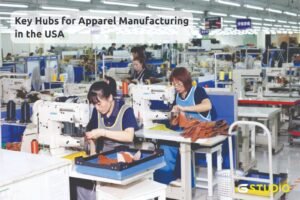
Apparel Manufacturers in the USA: An In-Depth Industry Overview
The apparel manufacturing industry in the Joined together States has experienced critical changes over the a long time. Once a worldwide pioneer in material generation, the U.S. saw much of its fabricating move abroad in look of cheaper labor. In any case, later a long time have seen a resurgence in household apparel manufacturing driven by buyer request for moral generation, economical mold, speedier turnaround times, and bolster for local businesses. In this blog, we’ll investigate the current scene of apparel manufacturers in the USA, the focal points of working with household makers, eminent companies, challenges they confront, and trends forming the industry.
Why Choose Apparel Manufacturers in the USA?
Quality and Craftsmanship
American-made apparel is frequently related with higher quality due to strict quality control guidelines, skilled labor, and progressed manufacturing innovations. Many U.S. manufacturers focus on niche markets and prioritize craftsmanship over mass generation.
Ethical Labor Practices
Unlike some overseas factories that confront investigation for labor infringement, American manufacturers must comply with strict labor laws that guarantee reasonable compensation, secure working conditions, and workers’ rights. Brands that care approximately corporate social duty lean toward working with U.S.-based accomplices for this reason.
Faster Turnaround and Reduced Lead Times
Apparel production in the USA permits for speedier examining, prototyping, and conveyance. This is particularly important in today’s fast-paced fashion world where patterns can alter overnight. Decreased shipping times and household coordinations make it easier to oversee stock and react to showcase requests.
Lower Carbon Footprint
Creating garments locally diminishes the natural affect of transportation. Buyers are getting to be more eco-conscious, and working with U.S.-based apparel manufacturers in the USA helps brands lower their carbon impression.
Key Hubs for Apparel Manufacturing in the USA
 Los Angeles, California
Los Angeles, California
LA is the heart of the American fashion industry, especially for contemporary and streetwear brands. The Fashion District in Downtown LA hosts hundreds of manufacturers, pattern makers, and fabric suppliers. The city is known for quick production cycles and its large network of cut-and-sew operations.
New York City, New York
NYC, particularly the Garment District in Manhattan, remains a hub for high-end fashion production. Although the number of factories has declined, it still plays a key role in sample making and small-batch production for luxury brands.
North Carolina and South Carolina
These states have a rich history in textile manufacturing. While much of the traditional mill work has shifted abroad, companies in the Carolinas continue to produce high-quality textiles and are seeing a revival due to nearshoring efforts.
Texas and the Midwest
States like Texas, Ohio, and Illinois are home to several factories focusing on workwear, denim, and uniforms. These regions benefit from lower operating costs and a growing demand for domestically produced goods.
Top U.S. Apparel Manufacturers

Here are some notable American apparel manufacturers in the USA known for their quality, transparency, and innovation:
American Apparel
Although the original company went bankrupt, it was revived under new ownership with a continued commitment to producing basics in the USA. They are known for their vertically integrated operations and focus on ethical production.
Royal Apparel
Royal Apparel specializes in American-made, eco-friendly garments including organic cotton t-shirts, hoodies, and fashion basics. They serve both retail and wholesale clients and offer private label services.
American Giant
American Giant gained fame for its high-quality sweatshirts and commitment to domestic production. Their entire supply chain, from cotton farming to sewing, happens in the USA.
Bella+Canvas
A favorite among blank apparel buyers, Bella+Canvas focuses on high-quality basics with a commitment to sustainability and ethical labor practices. Their modern fit and premium fabrics have made them a staple in the promotional apparel industry.
Good Clothing Company
This woman-owned company offers small batch manufacturing for emerging designers and brands. They emphasize ethical production, quality craftsmanship, and sustainable materials.
Challenges Facing U.S. Apparel Manufacturers
Despite the growing interest in domestic manufacturing, companies still face several hurdles:

Higher Labor and Operational Costs
Compared to overseas options, U.S. manufacturing is significantly more expensive. This makes it challenging for brands to compete on price, especially in the fast fashion segment.
Limited Workforce
The skilled labor pool for sewing, pattern making, and other technical roles has shrunk. As the industry faded over the decades, fewer young workers entered the field, creating a gap in expertise.
Scalability Issues
Small-batch production and local factories are ideal for startups and luxury brands but may not be suitable for large-scale production needs due to capacity limitations.
Supply Chain Fragmentation
Sourcing materials, trims, and other components domestically can be difficult, as many textile mills and suppliers have shut down or moved overseas.
Trends Shaping the Future of U.S. Apparel Manufacturing
Nearshoring and Reshoring
In response to global disruptions like COVID-19 and geopolitical tensions, brands are bringing production closer to home. Nearshoring to countries like Mexico or reshoring to the U.S. is becoming a strategic move to improve reliability and control.
Automation and Technology
Manufacturers are investing in advanced machinery, 3D knitting, robotics, and AI-driven design tools to improve efficiency and reduce costs. Smart factories are helping close the gap between U.S. and overseas labor costs.
On-Demand Manufacturing
Brands are shifting toward made-to-order or limited runs, reducing waste and inventory risks. This model aligns perfectly with the capabilities of domestic factories offering quick turnaround.
Sustainability and Transparency
Consumers want to know where and how their clothes are made. American manufacturers who prioritize ethical sourcing, sustainability, and transparent business practices are gaining favor with conscious buyers.
Conclusion
The apparel manufacturing industry in the USA is no longer almost volume—it’s almost esteem. Brands looking to offer morally created, high-quality garments with speedier lead times are turning to residential industrial facilities to meet cutting edge shopper desires. Whereas challenges like fetched and versatility stay, the industry’s development is being fueled by advancement, supportability, and a move in customer priorities.
For businesses and business visionaries entering the fashion space, joining forces with U.S.-based apparel manufacturers in the USA offers not fair a generation arrangement, but a key advantage. By remaining near to the customer and adjusting rapidly to showcase patterns, household manufacturing is balanced for a solid and economical future.

0 comments